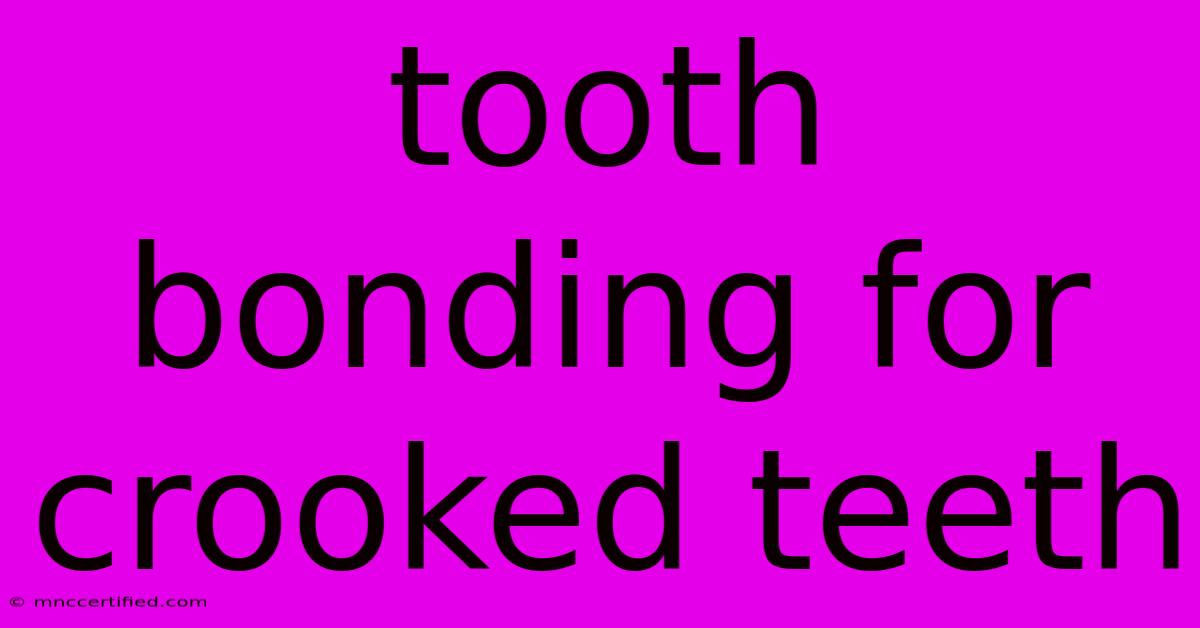Tooth Bonding For Crooked Teeth

Table of Contents
Tooth Bonding for Crooked Teeth: A Straightforward Solution?
Are you self-conscious about slightly crooked teeth but hesitant about extensive orthodontic treatment? Tooth bonding might be the straightforward solution you've been searching for. This cosmetic procedure offers a quick and less invasive way to improve the appearance of minor imperfections, including slightly crooked teeth, gaps, and chipped teeth. Let's delve deeper into how tooth bonding works and whether it's the right choice for you.
What is Tooth Bonding?
Tooth bonding is a cosmetic dental procedure that uses a tooth-colored resin material to repair and reshape teeth. The resin is carefully applied to the tooth surface, sculpted to the desired shape, and then hardened with a special light. This process is minimally invasive, requiring no removal of tooth structure, unlike veneers or crowns. For crooked teeth, bonding can effectively camouflage minor misalignments, creating a straighter, more aesthetically pleasing smile.
Is Tooth Bonding Right for Crooked Teeth?
While tooth bonding can significantly improve the appearance of slightly crooked teeth, it's crucial to understand its limitations. It's not a replacement for orthodontic treatment like braces or Invisalign if you have severely crooked teeth, significant bite problems, or overcrowding. Bonding is most effective for addressing minor imperfections, such as:
- Minor gaps between teeth: Bonding can fill small spaces, creating a more uniform and aligned smile.
- Slightly rotated teeth: Small rotations can often be corrected with bonding, making teeth appear straighter.
- Chipped or worn teeth: Bonding can repair chips and restore the natural shape of teeth, contributing to an improved alignment.
If your crooked teeth are severe or significantly impact your bite, orthodontic treatment is a more suitable and long-lasting solution. A consultation with a dentist or orthodontist is essential to determine the best course of action for your specific needs.
The Tooth Bonding Procedure: A Step-by-Step Guide
The tooth bonding procedure is typically completed in a single appointment and is relatively quick and painless. The steps generally include:
- Examination and Preparation: Your dentist will examine your teeth and discuss your goals. The teeth to be bonded will be cleaned and slightly roughened to ensure optimal adhesion of the resin.
- Resin Application: A tooth-colored resin material is carefully applied to the prepared tooth surface. The dentist will shape and mold the resin to correct the imperfections and improve the tooth's alignment.
- Hardening: A special light is used to harden the resin, making it strong and durable.
- Polishing and Finishing: The bonded area is polished to ensure a smooth, natural-looking finish.
Advantages of Tooth Bonding for Crooked Teeth
- Cost-effective: Compared to orthodontics, tooth bonding is generally a less expensive option for minor corrections.
- Quick procedure: The procedure is typically completed in a single appointment, saving you time and effort.
- Minimally invasive: No tooth structure is removed, preserving the natural tooth.
- Natural-looking results: The tooth-colored resin blends seamlessly with your natural teeth.
Disadvantages of Tooth Bonding for Crooked Teeth
- Not suitable for severe misalignment: Bonding is only effective for minor crookedness.
- Less durable than orthodontics: Bonded teeth are more susceptible to staining and chipping compared to natural teeth. Proper oral hygiene is crucial.
- Potential for staining: The bonding material can stain over time, especially with dark-colored beverages like coffee and tea.
- Requires maintenance: Regular dental checkups are essential to ensure the longevity of the bonding.
Maintaining Your Bonded Teeth
To maximize the lifespan and aesthetic appeal of your bonded teeth, follow these guidelines:
- Practice excellent oral hygiene: Brush and floss regularly to prevent staining and decay.
- Avoid abrasive foods: Avoid biting into hard candies or ice to prevent chipping or damage.
- Attend regular dental checkups: Schedule routine checkups for monitoring and cleaning.
Conclusion: Is Tooth Bonding Right for You?
Tooth bonding can be an excellent solution for individuals with minor crooked teeth who seek a quick, less invasive, and cost-effective cosmetic improvement. However, it's crucial to have a thorough consultation with a dentist to determine if it's the appropriate treatment for your specific situation. If your misalignment is significant, orthodontic treatment is recommended for long-term correction and overall oral health. Remember to always choose a qualified and experienced dentist for optimal results and safety.
Keywords: tooth bonding, crooked teeth, cosmetic dentistry, dental bonding, bonding for crooked teeth, minor teeth imperfections, gaps between teeth, chipped teeth, resin bonding, dental procedure, affordable smile correction, quick dental solution, minimally invasive dentistry, cosmetic dental procedure, maintaining bonded teeth.

Thank you for visiting our website wich cover about Tooth Bonding For Crooked Teeth. We hope the information provided has been useful to you. Feel free to contact us if you have any questions or need further assistance. See you next time and dont miss to bookmark.
Featured Posts
-
A Man On The Inside Netflix Comedy Review
Nov 22, 2024
-
Captain Tom Family Faces Mismanagement Scrutiny
Nov 22, 2024
-
Las Vegas Real Estate Investment
Nov 22, 2024
-
Pei Responsible Investment Forum
Nov 22, 2024
-
Espn Lewis Commits To Colorado
Nov 22, 2024